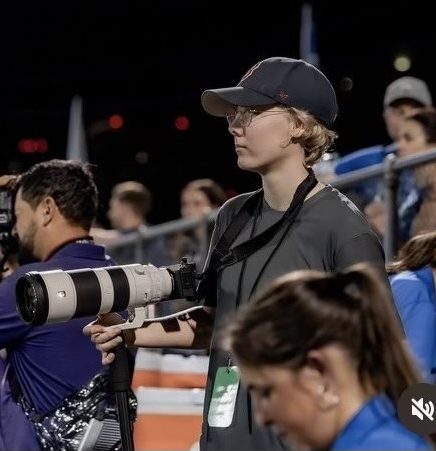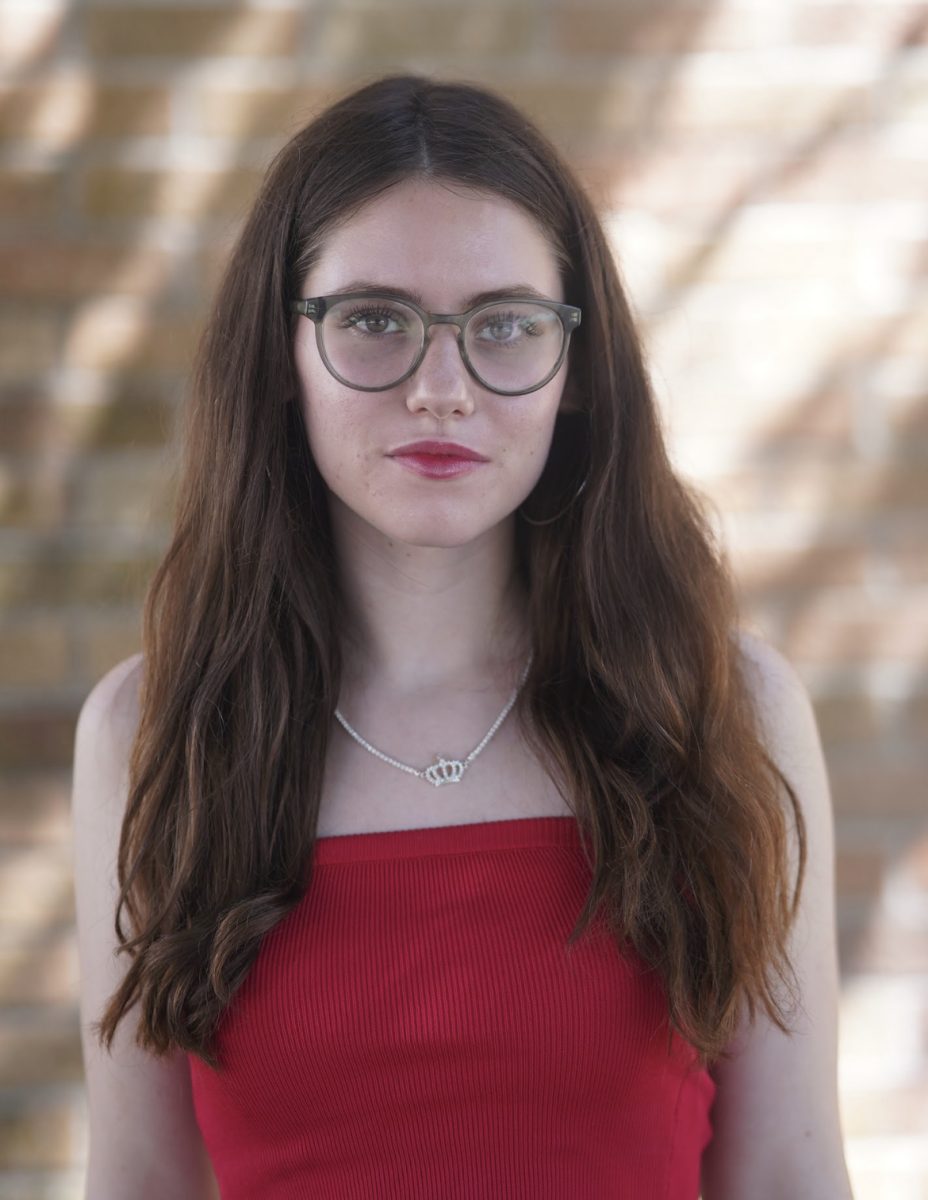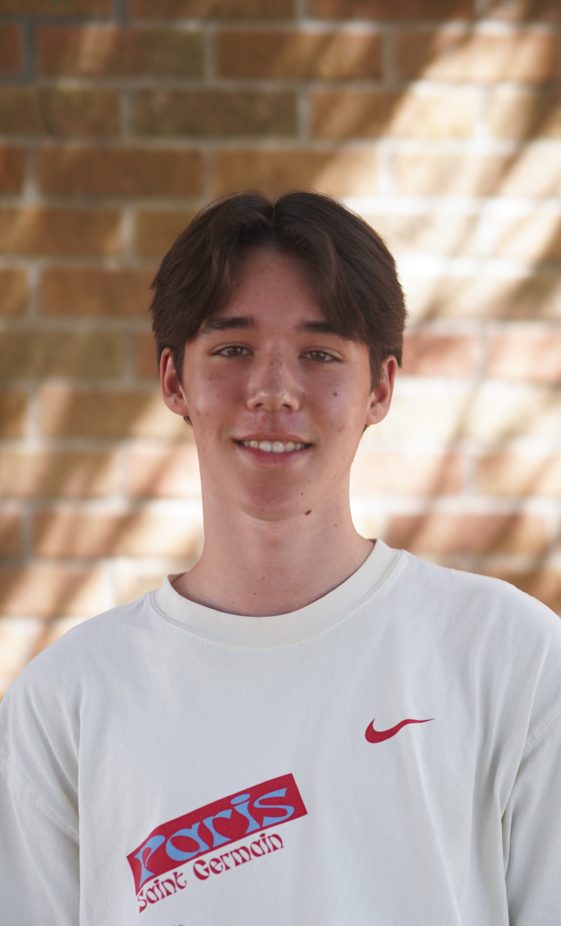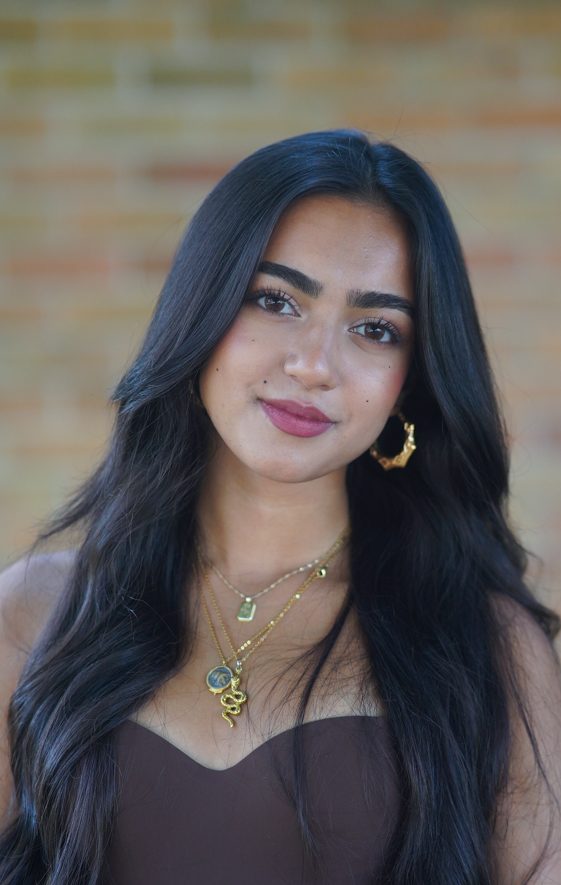In my mind, journalism is like a doughnut. Take a bite of the center (your comfort zone) and you eat nothing but air. Take a bite of the ring (your growth zone) and you eat sugar, bread and happiness. This year, as co-online managing editor, I aimed to hit that sweet spot: a place where I challenged myself and grew as a journalist. For me, no journalistic endeavor tastes as sweet as multimedia.
At the beginning of the school year, I was a print journalist through and through. I had never made a podcast in my life, didn’t know where to start with broadcast and hesitated to adjust the settings on a camera. I savored the feeling of bringing stories to life with my words, but I itched to broaden my horizons. Stepping into my role as co-online managing editor, I traveled to the “online exclusives” section of The Shield Online. My childhood dream of becoming a TV news anchor flashed through my mind. I noticed that no podcasts or videos had been posted in months, and no staffers were planning to make one happen. Wanting to fill this gap, I decided to enter the world of multimedia journalism for the first time.
Throughout the year, I could not stop digging into the growth ring of the journalism donut. When I finished my first podcast, I made another. When no one else stepped up to make a video, I taught myself broadcast basics and made it happen. When a weekly photo essay fell behind, I picked up the slack and helped the process along. I am proud of how I always accepted challenges and did the things no one else wanted to do, even if I had no prior knowledge. I used the challenges I faced as a chance to grow and learn so that I could help other staffers figure out what multimedia is all about. Now, I mentor staffers in podcasting and collaborate with them on broadcast projects. I am proud of how far I have come as a multimedia journalist this year, and I can’t wait to dive even deeper into my passion for storytelling in the future.
When I first joined McCallum Journalism, I dreamed of using my voice to connect with others, like dressed-up news anchors on TV or well-spoken talk show hosts on podcasts. But as I began my journalism journey online, my class focused exclusively on print design and writing, things that I grew to love immensely. This year, after two years of writing nonstop, I decided to step into my challenge zone and tackle something that had always felt out of reach– hosting and editing a podcast. When I pitched the idea to my adviser, he told me he knew nothing about making podcasts and that our previous podcast editor, Theo Roe, was months deep into college out of state. My only resource was a Google Doc that Roe had made years ago with a few instructions on how to use the free web program Audacity. Feeling completely in the dark, I decided to persevere and teach myself how to make a podcast. So I contacted my friend who was a leader in an abortion rights organization, made a Zoom link and pressed record. I ended up with an hour of insightful and inspiring footage that seemed impossible to cut down to my 15-minute limit. After a month of hacking away at the playtime and figuring out how to work Audacity, I had a product that seemed almost ready to publish. I tried my hand at recording an intro and outro, inserted the theme song and wrote a short summary for the web draft. I had officially brought back The Shield’s Real Talk podcast after a year-long hiatus. I faced no shortage of challenges, from cutting it down to removing clicks to working with bad computer microphone audio. But I emerged on top, with an award-winning podcast that made real change and inspired me to continue my multimedia journey. Best of all, I was now The Shield’s resident audio engineer, and I could help any staffer who, like me, wanted to make a podcast but didn’t know where to start.
I keep a list on my phone of story ideas, and I recently brought one of my favorite podcast ideas to fruition. My third-ever podcast featured four of my school friends who aimed to become teachers, from music to kindergarten to high school math, despite the many struggles teachers face. Learning a thing or two from my other podcast experiences, I purchased a microphone, planned for the interview in advance and created an outline to guide my editing process. My knowledge of the podcasting process had improved drastically, and the microphone bumps and bad sound quality that plagued me in August were nowhere in sight. However, I had never before featured more than one guest, so figuring out interview questions and differentiating speakers was a brand new challenge. I figured out how to rearrange my questions on Audacity and decided to make my first two-part podcast. After the interview session finished, my four subjects said that they had never before been around other teens who shared their passion for teaching. Their discussion not only brought them together, but it also changed the way I thought about the future of education. Once the final podcast was published, I was so proud that I sent it to my history teacher, who works multiple jobs, is a mom and is always open about her struggles as a teacher. She sent the podcast to the entire history department at my school, and I have seen it make an impact. Heading into my senior year, I am proud of how far I have come as an audio engineer, and I frequently use my podcast skills to help other staffers. Last week, I worked with a new staffer to turn a phone recording into a thought-provoking podcast that is almost ready to upload. She didn’t know where to begin, so I showed her how to use Audacity, taught her everything I knew about podcasting and watched her confidence grow every step of the way.
Banned Book Club fights censorship, fosters community, conversation … one book at a time
On my first day as co-online managing editor, I was told that The Shield needed to publish three eligible videos in order to be eligible for an SNO badge. With the end of the school year far out of reach and dozens of other stories on my plate, this did not seem like a priority. Fast forward to April and The Shield published no videos and no plan to make one. In my mind, the months of praying that three videos would magically appear were over. Despite my nonexistent broadcast journalism experience, I decided I would be the one to make it happen. I enlisted my friend to write a story and assist with interviews, and I would film and edit the video. I learned how to set up a tripod and ring light, wrote a few interview questions and headed down to the library to film a library tour. As I sat down to edit and struggled to break down an hour of interview footage and shaky b-roll, I realized that I had been chasing the wrong story the entire time. Reflecting on relevant portions of the library tour interviews, I decided to make the video about the influence of the McCallum Banned Book Club instead. I interviewed the founder and learned that there was more to the story than I had ever imagined. After hours upon hours of editing, I had a three-minute video that I was proud of. It lifted the voices of student activists and readers alike and brought attention to an impactful but little-covered group at McCallum. By the end of the tedious editing process, I had figured out how to create videos, edit videos and make voiceovers for videos, all things I had no clue about just weeks before. Plus, I shared my knowledge with a staffer and helped her learn the art of broadcast journalism alongside me. I applied my newfound knowledge and made another video with Alice Scott. This year I took steps to make sure that no multimedia story seemed out of reach for staffers. Next year, I aim to make many more broadcast packages and share my knowledge with every single staffer. I don’t want videos to be a last-minute effort for The Shield–I want them to be an abundant and valued medium of storytelling.
During my first year on staff for The Shield, I wrote a story about board game recommendations from a math teacher who owned over 400 games. As I brainstormed the best way to convert my print page design to web, I was introduced to the idea of flip cards. After I made my first set of flip cards, with categories and photos on the front and game descriptions on the back, I became obsessed with creating interactive web animations. This year, as I stepped into my role as co-online managing editor, I determined that the best way to make The Shield’s website stand out was to include more multimedia elements in our stories, and there was no better place to start than flip cards. This time, however, I wanted to step out of my comfort zone and attempt to tell the entire story through flip cards. With my favorite coffee drink in season, I used a 10-point scale across five categories and ranked eight pumpkin spice lattes from various coffee shops around Austin, Texas. Paying out of my own pocket, I photographed every latte, stayed true to my ranking criteria, created my own feature image on Canva and transformed the sugar explosion in my stomach into a short summary of what the experiment was all about. I struggled to summarize my feelings about each drink in a way that was concise and creative, but after no short time, I had rankings and explanations I was proud of. Still, I struggled to fit both the photos and words neatly within the dimensions of the card, but I kept trying until I found a method that worked: doing two flip cards per row with other adjustments in the margins and padding. Through creating flip cards for this story, along with designing a feature image and writing a short review, I became more confident in my abilities as a web editor and felt inspired to teach others about interactive story elements. After this story was published, The Shield created numerous other flip cards, often under my guidance, and pushed to create a better reader experience through animations whenever possible.
Every Tuesday, The Shield publishes a photo essay with ten captions about a highlight of the school week. Staffers scramble to sign up for captions, interview their subjects and finish writing before the clock strikes midnight, and my co-editors and I arrange the photos and their corresponding captions, brainstorm intro and headline ideas and edit the web draft one more time. Tuesday Top 10s are beautiful chaos, where staffers sharpen their journalism skills and every part of the McCallum experience from the football team to the fashion show is represented. With the help of my co-editors, I stepped up to execute every week’s Tuesday Top 10 in order to help create a product that makes our website better, even if it meant spending every Tuesday night in front of my computer. In March, a student in the prerequisite photography class for newspaper photographed a skill day at the LBJ Fire Academy, where AISD students train. I wanted his beautiful photos to be used for something, but the staff was too busy working on the print issue to take on a photo essay project. I rounded up two journalism students in the prerequisite class to complete the photo essay with and decided that I would use it as an opportunity to teach them how to write captions and work with photos. I taught them how to conduct interviews and write effective captions, and I worked with them to communicate with Fire Academy students from other schools. I put together a web draft, wrote an intro, chose a headline, organized the photos and captions and published. After a week of learning and editing, the freshmen had their first-ever byline. A few days later, the photo essay won an award. I am so happy I was able to share my journalism knowledge with others and create a valuable multimedia addition to The Shield Online.







